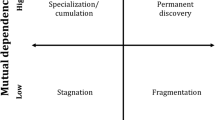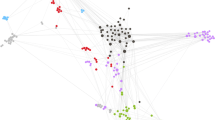Abstract
In science mapping, bibliographic coupling (BC) has been a standard tool for discovering the cognitive structure of research areas, such as constituent subareas, directions, schools of thought, or paradigms. Modelled as a set of documents, research areas are often sorted into document clusters via BC representing a thematic unit each. In this paper we propose an alternative method called age-sensitive bibliographic coupling: the aim is to enable the standard method to produce historically valid thematic units, that is, to yield document clusters that represent the historical development of the thematic structure of the subject as well. As such, the method is expected to be especially beneficial for investigations on science dynamics and the history of science. We apply the method within a bibliometric study in the modern history of bioscience, addressing the development of a complex, interdisciplinary discourse called the Species Problem. As a result, a quantitative and qualitative comparison of the standard and the proposed method of bibliographic coupling will be reported, together with a pilot study on the cognitive–historical structure of the Species Problem, regarding an important fragment of the discourse.






Similar content being viewed by others
Notes
In Table 3 only journal publications are demonstrated, therefore, the actual number of references included in the table is smaller than the size of the whole core.
References
Ereshefsky, M. (1992). The units of evolution: Essays on the nature of species. Cambridge: MIT Press.
Ghiselin, M. T. (1974). Radical solution to species problem. Systematic Zoology, 23(4), 536–544.
Hull, D. L. (1978). Matter of individuality. Philosophy of Science, 45(3), 335–360.
Hull, D. L. (1988). Science as a process: An evolutionary account of the social and conceptual development of science. Chicago: University of Chicago Press.
Kessler, M. M. (1963). Bibliographic coupling between scientific papers. American Documentation, 14(1), 10–25.
Langfelder, P., Zhang, B., & Horvath, S. (2008). Defining clusters from a hierarchical cluster tree: the Dynamic Tree Cut package for R. Bioinformatics, 24(5), 719–720.
Mayden, R. L., & Mayden, R. L. (1997). A hierarchy of species concepts: The denouement in the saga of the species problem. In M. F. Claridge, H. A. Dawah, & Wilson (Eds.), Species, the units of biodiversity (pp. 381–424). London: Chapman and Hall.
Mcouat, G. R. (1996). Species, rules and meaning: The politics of language and the ends of definitions in 19th century natural history. Studies in History and Philosophy of Science, 27(4), 473–519.
Mcouat, G. R. (2001). From cutting nature at its joints to measuring it: New kinds and new kinds of people in biology. Studies in History and Philosophy of Science, 32A(4), 613–645.
Price, D. J. (1970). Citation measures of hard science, soft science, technology, and nonscience. In C. E. Nelson & D. K. Pollack (Eds.), Communication among scientists and engineers (pp. 3–22). Lexington, MA: Heath.
Small, H. (1973). Co-citation in the scientific literature: A new measure of the relationship between two documents. Journal of the American Society for Information Science, 24(4), 265–269.
van Raan, A. F. J. (2005). Reference-based publication networks with episodic memories. Scientometrics, 63(3), 549–566.
Acknowledgments
This paper was supported by the János Bolyai Research Scholarship of the Hungarian Academy of Sciences.
Author information
Authors and Affiliations
Corresponding author
Appendix
Appendix
See Fig. 7.
Rights and permissions
About this article
Cite this article
Soós, S. Age-sensitive bibliographic coupling reflecting the history of science: The case of the Species Problem. Scientometrics 98, 23–51 (2014). https://doi.org/10.1007/s11192-013-1080-y
Received:
Published:
Issue Date:
DOI: https://doi.org/10.1007/s11192-013-1080-y





